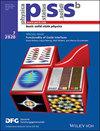Metalorganic Vapor‐Phase Epitaxy of +c/−c GaN Polarity Inverted Bilayer for Transverse Quasi‐Phase‐Matched Wavelength Conversion Device
IF 1.8
4区 物理与天体物理
Q3 PHYSICS, CONDENSED MATTER
引用次数: 0
Abstract
Photon‐pair generation based on optical parametric down‐conversion has attracted for the application as a light source for quantum information. Highly efficient wavelength‐conversion devices require a polarity‐inversion structure when using nitride semiconductors. A transverse quasi‐phase‐matching (QPM) polarity‐inverted GaN bilayer channel waveguide device is suitable for efficient wavelength conversion. This study designed a cross‐section device to satisfy the modal dispersion phase‐matching condition between the TM用于横向准相位匹配波长转换器件的 +c/-c GaN 极性反转双层层的金属有机气相外延
基于光参量下变频技术的光子对生成技术被广泛应用于量子信息光源。使用氮化物半导体时,高效波长转换器件需要极性反转结构。横向准相位匹配(QPM)极性反转氮化镓双层沟道波导器件适用于高效波长转换。本研究设计了一种横截面器件,以满足 TM02 模式泵浦光和 TM00 模式信号/idler 光之间的模态色散相位匹配条件。此外,AlN 氧化中间层通过金属有机气相外延(MOVPE)制造了 Ga 极/N 极(+c/-c)GaN 层。通过优化 -c-GaN 生长条件并将衬底偏角减小到 0.2°,生长出具有大无阶跃表面的 145 nm 厚膜层。接着,在电炉中氧化氮化铝层,然后使用 MOVPE 技术重新生长出 1500 nm 厚的 +c-GaN 层。通过将偏角减小到 0.2°,并优化-c-GaN 生长条件以避免形成小丘,可以实现无大台阶表面。这些结果为提高氮化镓横向 QPM 波长转换器件的效率铺平了道路。
本文章由计算机程序翻译,如有差异,请以英文原文为准。
求助全文
约1分钟内获得全文
求助全文
来源期刊
CiteScore
3.30
自引率
6.20%
发文量
321
审稿时长
2 months
期刊介绍:
physica status solidi is devoted to the thorough peer review and the rapid publication of new and important results in all fields of solid state and materials physics, from basic science to applications and devices. Being among the largest and most important international publications, the pss journals publish review articles, letters and original work as well as special issues and conference contributions.
physica status solidi b – basic solid state physics is devoted to topics such as theoretical and experimental investigations of the atomistic and electronic structure of solids in general, phase transitions, electronic and optical properties of low-dimensional, nano-scale, strongly correlated, or disordered systems, superconductivity, magnetism, ferroelectricity etc.

 求助内容:
求助内容: 应助结果提醒方式:
应助结果提醒方式:


